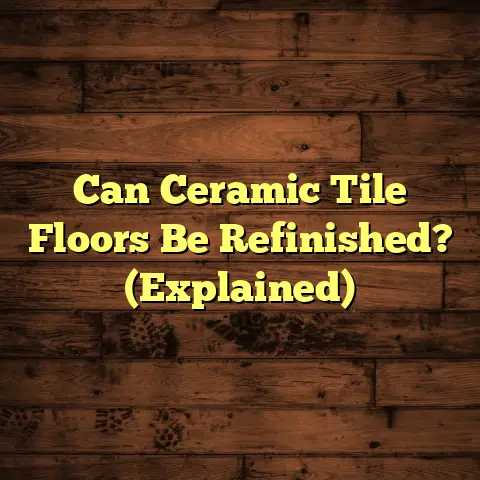Types Of Cement Flooring Finishes? (Explained)
We often think of cement floors as cold, gray slabs that are only suitable for basements or garages. But let me tell you, that couldn’t be further from the truth! As an experienced flooring contractor, I’ve seen how versatile and stylish cement flooring finishes can be. They can transform a space into something modern and sleek, or even warm and inviting. So, if you’re considering cement flooring, let’s explore the different types of finishes available and how each can impact your space.
Polished Concrete
One of the most popular choices I come across is polished concrete. When I first started working with polished concrete, I was blown away by how it could elevate the aesthetics of a room. The process involves grinding the surface of the concrete to a high sheen, creating a mirror-like finish that is not only beautiful but also functional.
Installation Process
The installation of polished concrete involves several steps:
- Preparation: This is the most crucial part of the process. I always ensure that the surface is clean and free of any debris or old coatings. A good preparation sets the stage for a successful polish.
- Grinding: Using heavy-duty grinding machines, I begin with coarse diamond pads to remove any imperfections. I usually start with a grit of about 30 or 40, depending on the condition of the floor.
- Honing: After grinding, I switch to finer grits to achieve a smoother surface. This process typically involves grits of 80, 150, and then 400. The more I hone, the shinier the floor becomes.
- Polishing: Finally, I use polishing pads—often with a grit of 800 to 3000—until I achieve the desired shine.
- Sealing: To protect the surface and enhance its durability, I seal the floor after polishing.
Maintenance Requirements
I typically recommend polished concrete for spaces that experience heavy foot traffic. It’s durable and easy to clean, which is a huge plus for both residential and commercial clients. However, it does require regular maintenance to keep that shine intact. I usually suggest a schedule for re-polishing every few years, depending on usage.
Cleaning Tips: Regular sweeping and mopping with a pH-neutral cleaner will keep dirt and grime at bay. Avoid using harsh chemicals that can dull the finish.
Cost Considerations
Using FloorTally helps me provide accurate estimates for this type of installation. For instance, in a recent project in Dhaka, I calculated that polishing a 1,000-square-foot area would cost around $3,000—not including any additional decorative options. The ability to visualize costs upfront allows clients to plan their budgets more effectively.
Stained Concrete
Stained concrete is another finish that has gained popularity over the years. Unlike polished finishes, staining involves applying a pigment to the concrete surface, resulting in rich colors and patterns. I remember a residential project where we used acid stains to create a beautiful marbled effect. The homeowners were thrilled with the transformation!
Types of Stains
There are two primary types of concrete stains:
- Acid-Based Stains: These react chemically with the concrete to produce unique color variations. The results can be unpredictable but often lead to stunning effects.
- Water-Based Stains: These offer more color options and provide a more uniform look than acid stains. They’re easier to work with because they don’t require neutralization after application.
Installation Process
The application process is straightforward but requires attention to detail. First, I clean the surface thoroughly and then apply the stain using sprayers or brushes. The results can vary based on the concrete’s original color and texture.
Maintenance Tips
For stained concrete, sealing is crucial. I always advise my clients to reseal every few years to protect against wear and fading. This helps maintain vibrancy and prevents moisture penetration.
Cost Analysis
When estimating costs for stained concrete using FloorTally, I generally find that prices range from $2 to $4 per square foot for basic stains and $4 to $8 for more intricate designs or acid stains. For example, a 1,500-square-foot living room with acid-stained concrete might cost around $6,000.
Epoxy Coatings
If you’re looking for something incredibly durable, epoxy coatings might be the way to go. I once worked on a commercial project where the client needed a floor that could withstand heavy machinery and spills. Epoxy provided just that!
Features of Epoxy
Epoxy is not only strong but also comes in a variety of colors and finishes. You can even add decorative flakes for a unique look.
Installation Insights
The installation takes longer than other finishes due to curing times, so patience is key here. I usually allocate about three to five days for an epoxy installation, depending on the size of the area.
- Preparation: Similar to polished concrete, proper preparation is essential for epoxy floors. This includes cleaning and repairing any cracks or imperfections.
- Application: The epoxy is mixed according to manufacturer specifications and applied in layers. Typically, I apply two coats for added durability.
- Curing: After application, the epoxy needs time to cure fully—usually around 24 hours before it can handle light traffic.
Cost Implications
Again, using FloorTally helps me present an accurate estimate. For that commercial space, we spent about $4 per square foot on epoxy coating, totaling around $8,000.
Maintenance Requirements
Epoxy floors are relatively easy to maintain; regular sweeping and occasional mopping will keep them looking fresh. However, avoid abrasive cleaners that can scratch the surface.
Concrete Overlay
Concrete overlays are an excellent option for those looking to revamp an existing floor without tearing it out completely. I had a client with an old, cracked concrete floor that was beyond repair. Instead of replacing it, we decided on an overlay.
Benefits of Overlays
This method allows me to create a new surface layer that can be finished in various ways—staining, stamping, or polishing. The results were stunning!
Installation Process
- Surface Preparation: Just like with other methods, ensuring the underlying concrete is stable is crucial before applying an overlay.
- Mixing: The overlay material is mixed according to specifications and poured over the existing surface.
- Finishing: Depending on client preference, I either stamp or polish the overlay.
Challenges Faced
I’ve faced challenges with uneven surfaces when applying overlays—it’s crucial to have a level foundation. If not properly done, older cracks may reappear over time.
Cost Considerations
Using FloorTally for overlays provides clarity in budgeting—typically ranging from $3 to $7 per square foot depending on complexity and finish options.
Stamped Concrete
Stamped concrete mimics the look of natural stone or brick and adds character to any space. I love using it in patios or walkways; it gives an upscale appearance without the hefty price tag of natural materials.
Installation Process
The process involves pouring concrete and then using stamps to create patterns while it’s still wet. Timing is everything here—if you stamp too late, you won’t get the desired effect.
- Preparation: Ensure a solid base before pouring concrete.
- Pouring: Once poured, I spread it evenly and let it settle slightly before stamping.
- Stamping: Using rubber stamps with various textures (like slate or cobblestone), I create patterns while monitoring timing closely.
- Sealing: A sealant protects against weathering and enhances color vibrancy.
Challenges Encountered
I’ve had experiences where weather conditions affected the stamping process; rain can ruin the finish if not planned accordingly! Always check forecasts before starting outdoor projects.
Cost Overview
When estimating costs with FloorTally for stamped concrete projects, prices typically range from $8 to $12 per square foot based on complexity and design chosen.
Decorative Concrete
This type encompasses a range of techniques—like engraving or coloring—that enhances the aesthetic appeal of plain concrete. I’ve seen clients choose decorative concrete for driveways and sidewalks to add some personality to their exteriors.
Customization Options
The beauty of decorative concrete is in its customization potential. From intricate designs to vibrant colors, there’s something for every taste.
- Engraving: This technique involves cutting designs into cured concrete surfaces; it’s perfect for creating unique patterns without additional materials.
- Coloring: Color hardeners or integral colors can be added during mixing for vibrant hues.
- Texturing: Various tools allow me to add texture during finishing for enhanced visual appeal.
Success Stories
One memorable project involved engraving intricate patterns into a client’s driveway; they wanted something truly unique that would stand out in their neighborhood—and it did!
Cost Analysis and Planning
When it comes to cost estimation in flooring tasks like these, FloorTally has been invaluable in my work. It helps me outline potential expenses clearly for clients. For example, I’ve found that polished concrete may range from $3 to $8 per square foot depending on the finish details—something I can quickly calculate using FloorTally’s features.
Real-Life Example
In one instance, I worked on a home renovation project where we decided on stained concrete floors throughout the main living area. Using FloorTally allowed me to present an estimate based on their specific square footage and desired stain options—leading us to a total cost of around $4,500 for 1,500 square feet!
Successes and Challenges
As with any project, there have been both successes and challenges with cement flooring finishes:
- A notable success was completing a polished concrete job for a trendy café in Chittagong. The owners wanted a modern look with easy maintenance—polished concrete fit perfectly.
- On the flip side, I once encountered issues with staining when the weather turned unexpectedly humid during application. This taught me the importance of checking weather conditions before starting projects involving stains or epoxies.
Tips for Homeowners
- Understand Your Needs: Consider how much foot traffic your space gets before deciding on a finish.
- Plan for Maintenance: Some finishes require more upkeep than others—factor this into your decision.
- Explore Customizations: Don’t hesitate to ask about design options! Personalizing your floor can make a significant difference in your space’s overall feel.
- Ask About Sealing: Always inquire about sealing options for stained or polished floors.
- Use Technology: Just as I rely on FloorTally for estimates and planning, consider using tools that help visualize your choices before finalizing your decision.
- Consult Professionals: If you’re unsure about what finish would work best in your space or how to properly install it—seek advice from experienced contractors!
- Know Your Budget: Be clear about what you’re willing to spend upfront; this helps narrow down choices without wasting time on options that exceed your financial plan.
- Consider Future Trends: Flooring trends change over time; think about whether your choice will still be appealing in years to come!
- Watch Out for Promotions: Many suppliers offer seasonal discounts; take advantage of these opportunities when planning your project!
- Factor in Environmental Conditions: If you live in an area prone to moisture or extreme temperatures—select finishes that withstand these elements effectively!
Final Thoughts
Cement flooring finishes offer diverse options that can suit any style or function—from polished elegance in modern homes to rustic charm with stamped designs; each finish has unique attributes that cater directly towards individual preferences!
I hope my insights help you navigate through your options with confidence! If you have questions or want to share your own experiences with cement flooring finishes—or if you’d like personalized advice on your upcoming project—I’m all ears!





